#kolman helmschmid
Text


Visor in the form of a Human Face
c.1515
Attr. Kolman Helmschmid
Helmets fitted with masklike visors were a popular German and Austrian fashion about 1510 to 1540. With their visors forged and embossed as humorous or grotesque human masks, such helmets were often worn in tournaments held during the exuberant pre-Lenten (Shrovetide) festivals, celebrations somewhat akin to the modern Mardi Gras. Substitute visors of more conventional type were often provided for everyday use.
The MET (Accession Number: 04.3.286a)
#armor#fashion history#historical fashion#helmet#16th century#germany#kolman helmschmid#1510s#silver#gold#steel#armour#the met#i HATE this lmao
385 notes
·
View notes
Text
Steel Brocade: Puffed & Slashed Costume Armor
Surviving to this day in the collections of the world’s most illustrious museums are a group of three armors. These armors have much in common, but most striking is the attempts made by their armorers to render in steel a convincing portrayal of the puffed and slashed clothing fashionable to the early 16th century.
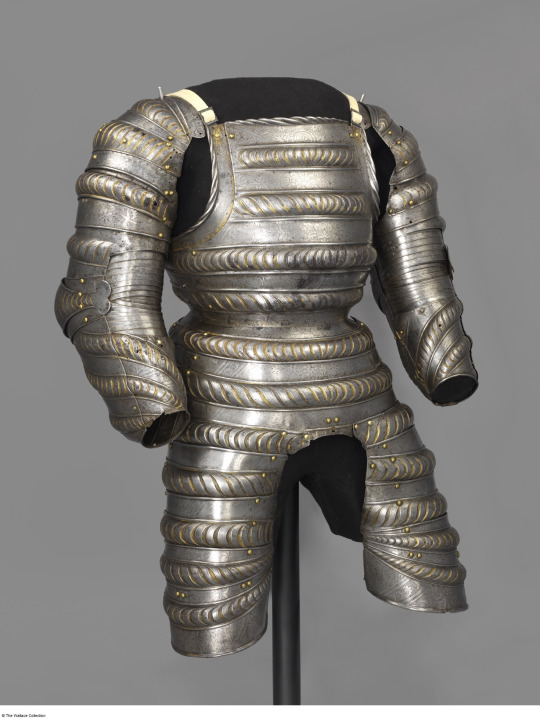


Though this fashion is synonymous with the landsknecht mercenaries who may have been responsible for popularizing it, the puffed and slashed style was enjoyed by members at all levels of society.

Portrait of Duke Henry of Saxony by Lucas Cranach the Elder, 1514, Staatliche Kunstsammlungen, Dresden.
The earliest of these three armors is housed at the Wallace Collection. Consisting only of a cuirass and arms, this armor is, at first glance, rather underwhelming when compared with the other armors in this group. Though the embossed bands styled with etched slashes embellished with gold provide the impression of a puffed and slashed doublet, the execution is all rather stiff, and lacks the impressive volume and fullness exemplified by the other armors.

It is for this reason that this armor, previously considered contemporary to the KHM and Metropolitan examples, has received relatively little attention. However, recent scholarship by Dr. Tobias Capwell suggests that this work is not, indeed, contemporary to the other examples, and is rather about ten years older, dating to ca. 1515. Dr. Capwell also considers this piece to be the work of Konrad Seusenhofer, a favored armorer of the Emperor Maximilian I.
Seen through this lens, not as a poorly executed contemporary of greater armors, but as a less developed ancestor to them, this armor takes on new life. It speaks to innovation and experimentation; an early attempt at a technique which would later be perfected.
The second in this line is the garniture of Wilhelm von Rogendorf, housed at the Kunsthistorisches Museum in Vienna.

This armor is unique for its condition, which is remarkably good. Not only does this armor retain more of its pieces than the other two, it is also accompanied by a number of “pieces of exchange,” elements which could be swapped out so the armor could be worn in the field.
Finished in 1523, as attested to by the date etched on the right shoulder strap, this armor was made for the Count Wilhelm von Rogendorf by Kolman Helmschmid and etched by Daniel Hopfer.

Wilhelm von Rogendorf himself was heir to a new, up-and-coming German noble family.

A medal showing Wilhelm von Rogendorf as a Knight of the Order of Calavatra, dated 1536, Kunsthistorisches Museum, Vienna.
Born in 1481 the second son of Kaspar von Rogendorf, Wilhelm became heir to his family’s estates when his elder brother Sigmund died in 1507, by which time Wilhelm was already a courtier at the Habsburg court. He entered into the service of King Charles I of Spain (later Emperor Charles V) no later than 1517 and was appointed Governor of Friesland. In 1522, Wilhelm accompanied Charles to Spain where he commanded a regiment of 4,000 landsknechts and was again placed in charge of a restless border territory. In 1524, he successfully captured the Fortress of Fuenterrabía from the French, which won him great praise from the Emperor. Shortly thereafter, Wilhelm was named Captain of the Imperial Bodyguard and given the governorships of Catalonia, the Cerdagne, and the Roussillon. Additionally, he was appointed to the Spanish chivalric Order of Calavatra. Wilhelm would retire from court in 1539, but would be recalled in 1541 to command Imperial troops against the Ottomans in Hungary. He would be killed later that same year at the siege of Buda by a stray cannonball.
Though Wilhelm’s armor is now displayed in its parade configuration, the surviving pieces of exchange attest to the fact that it was also an armor for combat. The cuirass is equipped with the long tassets common to the early 16th century. A pair of holes can be observed at the top of the last lame.

These holes correspond to holes at the top of the half-cuisses which accompany this armor, showing that these cuisses would be pointed to the tassets rather than worn separately.

In the rear, the cuirass is accompanied by a rump-defense, also known as a hoguine. Small turning pins near the waist allow this to be removed for combat.
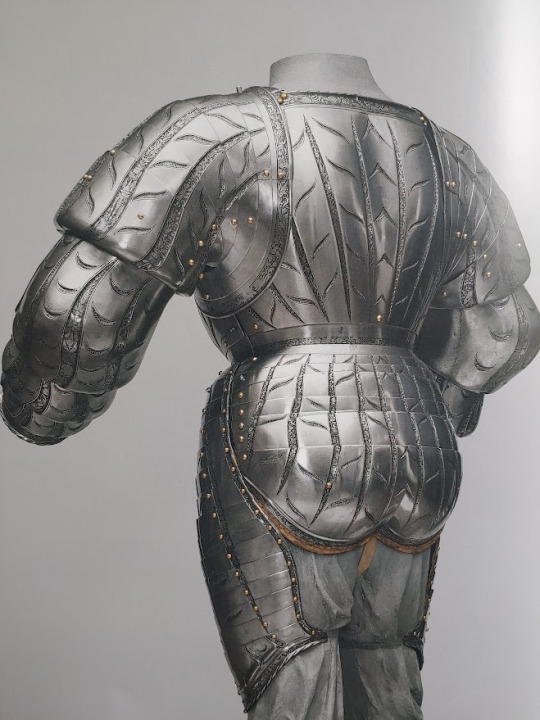
Both spaulders
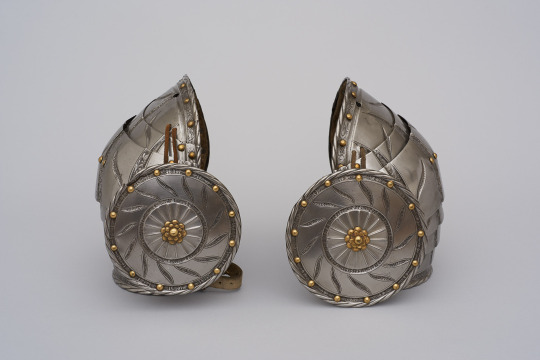
and gauntlets

survive. Additionally, the KHM retains the armor’s right vambrace

while the Wallace Collection holds the rerebrace and couter for the left arm.
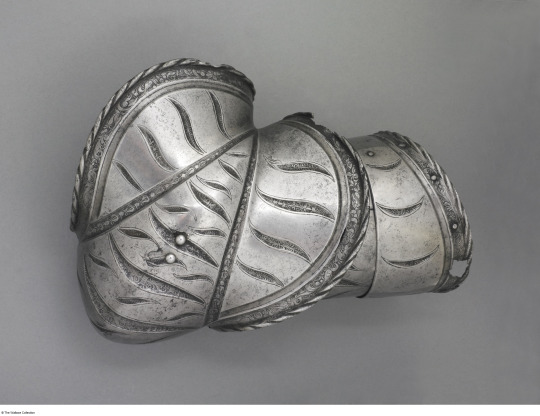
Recently, these pieces were assembled to show what the arm harness for field as a single unit would have looked like.
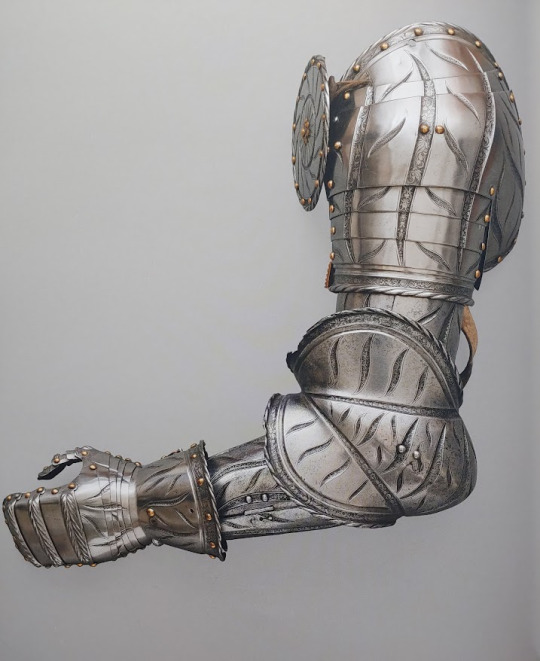
This armor would also have been accompanied by a gorget, now missing, and a helmet. Frequently, this armor is displayed alongside a close-helmet, however it is more likely the armor would have been accompanied by a burgonet similar in form to this example from the KHM.
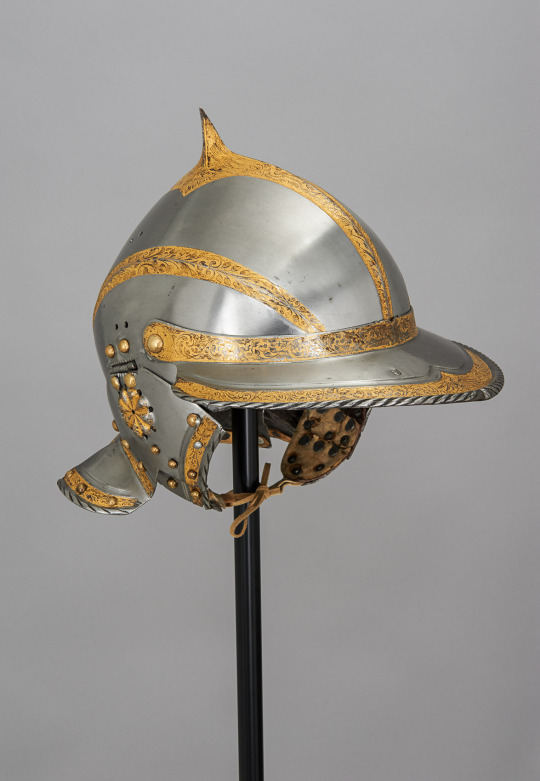
One final, unique surprise this armor holds is a hidden lance rest which is incorporated into the turned edge by the right arm. This rest folds down to allow a light lance to be braced atop it, and when folded up, is nearly invisible so as to not ruin the smooth surface of the breastplate with the prominent staples typically required for affixing a lance rest.

The third and final armor of this group is housed at the Metropolitan Museum of Art in New York City.

The least complete of these three armors, it may also be the most visually impressive. Comprised of only a backplate, hoguine, and arms, the puffs and slashes of this piece (also by Kolman Helmschmid and Daniel Hopfer) are ornately cusped. The slashed regions, displaying the gilded “fabric” beneath, and heavily etched to resemble an expensive silk brocade.
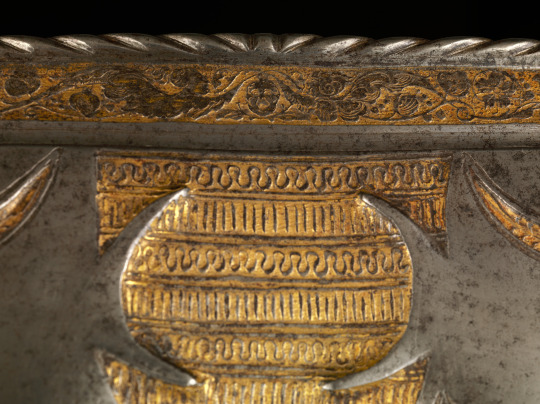
The sleeves of this armor are even more voluminous than those of the Rogendorf armor, though they are similarly articulated and provide the wearer with a surprising degree of mobility. It is thought that this armor may have been made for prominent Polish nobleman Jerzy Herkules Radziwill.
Interestingly, the hoguine of this armor is composed of two separate plates, rather than a single solid plate. Where the hoguine of the other two armors terminates in a decorative fabric border, the Met armor continues into two more articulated lames, covering the top rear of the thighs. Holes along the bottom edge suggest that this armor may have been accompanied by fully enclosing cuisses which pointed to the bottom of the fauld and hoguine.

Sources
“A Pair of Gauntlets.” Kunsthistorisches Museum Wien. https://www.khm.at/de/object/540164/.
“A Pair of Spaulders with Besagews.” Kunsthistorisches Museum Wien. https://www.khm.at/de/object/372772/.
Cranach, Lucas the Elder. “Portrait of Duke Henry of Saxony.” Staatliche Kunstsammlungen Dresden. https://skd-online-collection.skd.museum/Details/Index/246875.
Krause, Stefan. Fashion in Steel. Vienna: Kunsthistorisches Museum, 2017.
“Landsknecht Costume Armour.” Kunsthistorisches Museum Wien. https://www.khm.at/de/object/372771/.
“Left Upper Cannon and Couter.” The Wallace Collection. https://wallacelive.wallacecollection.org:443/eMP/eMuseumPlus?service=ExternalInterface&module=collection&objectId=60736&viewType=detailView.
“Open Burgonet.” Kunsthistorisches Museum Wien. https://www.khm.at/en/object/503346/.
“Parts of an Armour.” The Wallace Collection. https://wallacelive.wallacecollection.org:443/eMP/eMuseumPlus?service=ExternalInterface&module=collection&objectId=60519&viewType=detailView.
“Portions of a Costume Armor.” The Metropolitan Museum of Art. https://www.metmuseum.org/art/collection/search/27790.
“Vambrace.” Kunsthistorisches Museum Wien. https://www.khm.at/de/object/372773/.
“Wilhelm von Rogendorf.” Kunsthistorisches Museum Wien. https://www.khm.at/de/object/1409642/
.
#long post#armor#armour#landsknecht#costume armor#art#history#renaissance#germany#german#hre#holy roman empire#europe#european#themet#metmuseum#khm#skd#wallace collection
1K notes
·
View notes
Text
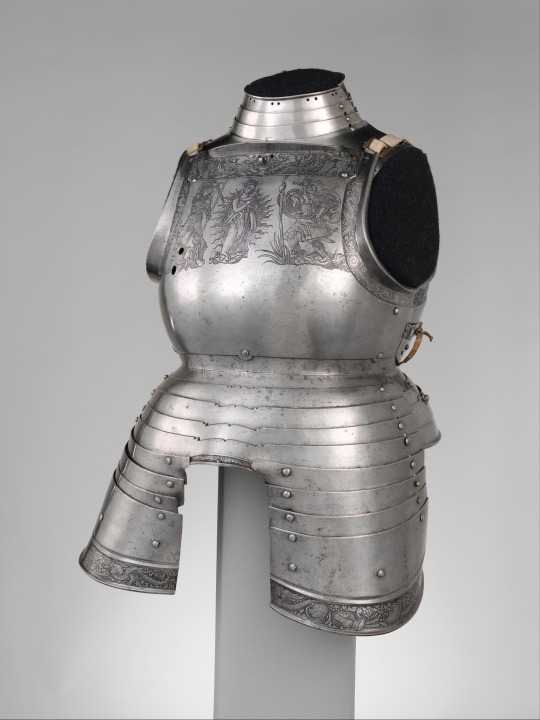

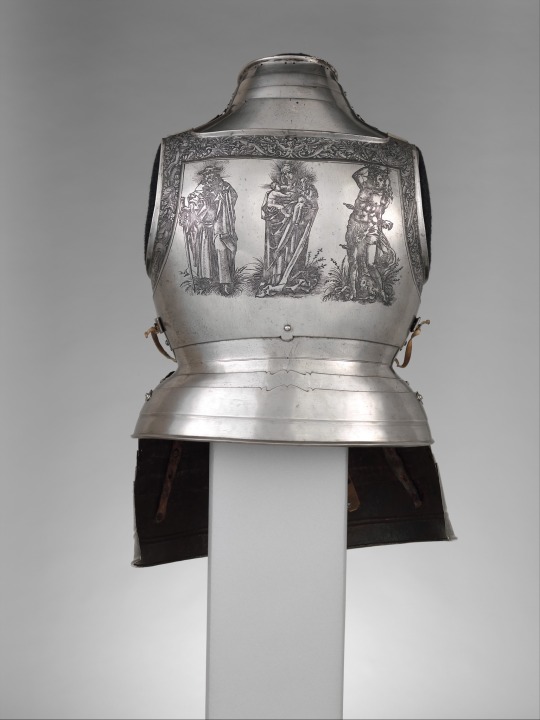
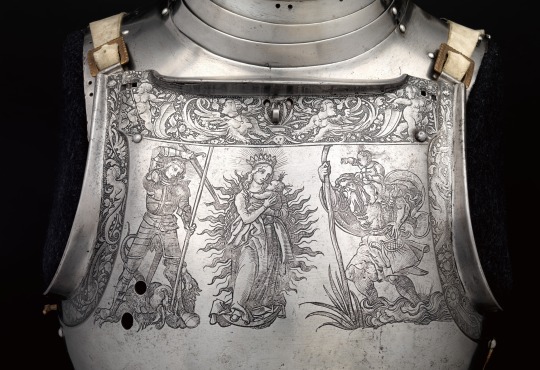
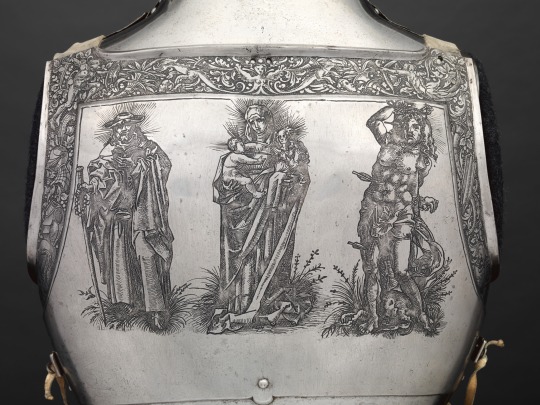
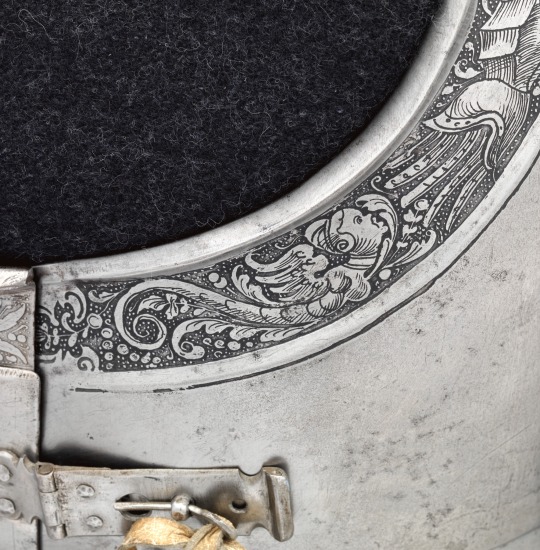

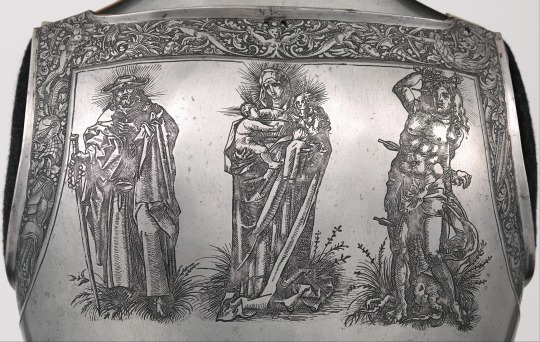
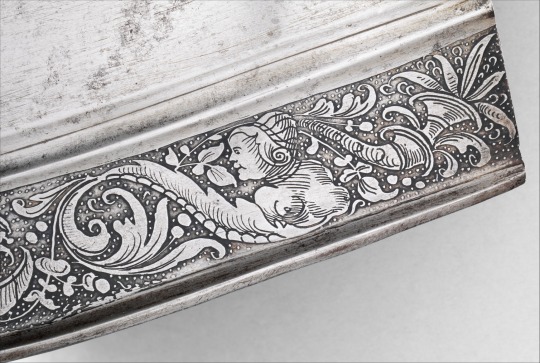
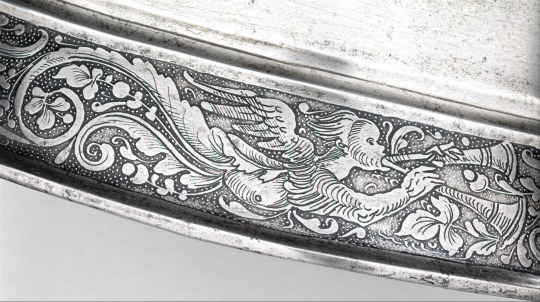
⚜️ Cuirass and Tassets (Torso and Hip Defense), ca. 1510–1520
Medium: Steel, leather
Dimensions:
Height - 105.4 cm
Weight - 8845 g
Armorer: Attributed to Kolman Helmschmid (German, Augsburg 1471–1532)
Decorator: Etching attributed to Daniel Hopfer (German, Kaufbeuren 1471–1536)
⠀
The decoration of this armor is an outstanding example of German figural etching. The etching has been attributed to Daniel Hopfer, a noted printmaker and armor etcher. Hopfer may have pioneered the technique of making prints from an etched metal plate, which revolutionized printmaking in the sixteenth century.
⠀
The figures on the breastplate depict major Christian saints and include the Virgin and Child flanked by Saint George and Saint Christopher. On the backplate, Saint Anne with the Virgin and Child is flanked by Saint James the Great and Saint Sebastian. The figure of Saint Sebastian pierced by arrows is copied from a woodcut made about 1507 by Hans Baldung Grien (1484 or 1485–1544).
🏛️ The Met
- -
⚜️ Кираса и тассеты (защита туловища и бедер), около 1510–1520 г.
Материалы: сталь, кожа
Размеры:
Высота - 105,4 см
Вес - 8845 г
Изготовление приписывается Коломану Кольману (Кольман Хельмшмид), Аугсбург (1471–1532)
Декораторативные элементы приписываются Даниэлю Хопферу (Кауфбойрен, 1471–1536)
⠀
Украшение этого доспеха является выдающимся образцом немецкого фигурного травления. Травлёный рисунок приписывается Даниэлю Хопферу, известному граверу и декоратору доспехов. Хопфер, возможно, был основоположником в техник�� изготовления отпечатков с травленой металлической пластины, которая произвела революцию в гравюре в XVI в.
⠀
Фигуры на нагруднике изображают главных христианских святых, в том числе Деву Марию с младенцем в окружении святых Георгия и Христофора. На оборотной стороне изображена Святая Анна с Девой Марией и младенцем по бокам от святого Иакова Великого и святого Себастьяна. Фигура святого Себастьяна, пронзенного стрелами, скопирована с гравюры на дереве, выполненной около 1507 года Хансом Бальдунгом Грином (1484/1485-1544).
🏛️ Метрополитен-музей, США
⠀
#armour #medievalarmour #armsandarmor #history #Cuirass #Tassets #Etching #Кираса #травление #тассеты #armor
#medieval#средневековье#middleages#history#armor#armours#история#harnisch#armadura#armour#cuirass#tassels#etching#травление#кираса#доспехи
86 notes
·
View notes
Text

pair of heavily articulated Gauntlets, attributed to Kolman Helmschmid
5 notes
·
View notes
Text

Before ascending to the Spanish throne, Charles lived in the Burgundian Netherlands, where he had been born in 1500. Raised there by Maximilian’s daughter, he shared his grandfather’s preference for German armorers. Charles’ patronage of Kolman and Desiderius Helmschmid of Augsburg brought them fame and set a fashion for elegant armor in which smooth surfaces alternate with vertical bands of gilded and engraved decoration. As a result of his conquest of the Duchy of Milan in 1525, Charles also gained access to the renowned workshop of Filippo Negroli, the sole armorer mentioned by Giorgio Vasari in his Lives of the Artists of 1550. Charles’ lavish commissions made the Royal Armory one of the greatest repositories of German and Italian armor in existence.
Desiderius Helmschmid, German, documented 1513–1579, Helmet of Emperor Charles V, Augsburg, c. 1540, Embossed, etched, and gilt steel, Patrimonio Nacional, Real Armería, Madrid.
0 notes
Text

Parts of an armour | Wallace Collection
Attributed to Kolman Helmschmid (1470 - 1532) , Armourer
Attributed to Daniel Hopfer (1470 - 1536), Etcher
Augsburg, Germany
Date: c. 1525 - c. 1530
Medium: Steel, copper alloy, satin, leather and gold, etched, pierced, chiselled, gilded and embossed
Weight: 16.3 kg, total weight
Inv: A30
A30 PARTS OF A FIELD ARMOUR
This outstanding armour exemplifies the great work of a master armourer, a perfect marriage of technical functionality and aesthetic sophistication.
It is of the finest workmanship, decorated with sunken bands etched with scrolled foliage, cornucopias, grotesque figures and birds, on a gilt granulated ground, their inner sides decorated with embossed scallops etched with leaves and engrailed ornament. On the pauldrons, couters and tassets are placed conspicuous, sunk or embossed trefoils etched and gilt. The gauntlets, leg armour and reinforcing plates are missing, although several fragments of these parts are preserved in other collections (see below). With the exception of the gorget (made in France c. 1869) the armour is otherwise entirely without restoration, the helmet retaining its original quilted lining: it is almost certainly the work of Kolman Helmschmid, although it is not marked. Compare the armet A165, also produced in the Helmschmid workshop around this time.
0 notes
Photo
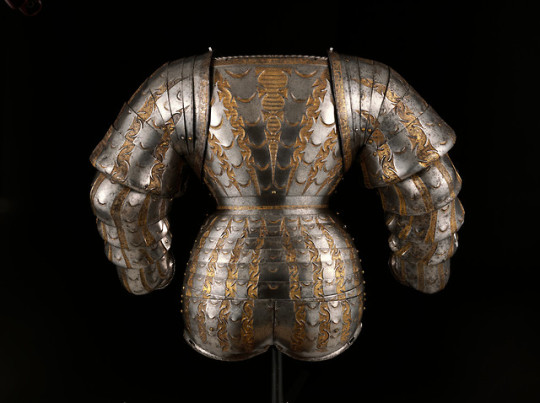

Portions of a Costume Armor
Armorer: Kolman Helmschmid (German, Augsburg 1471–1532)
Date: ca. 1525
Geography: Augsburg
Culture: German, Augsburg
Medium: Steel, gold
The Metropolitan Museum of Art
7 notes
·
View notes
Text
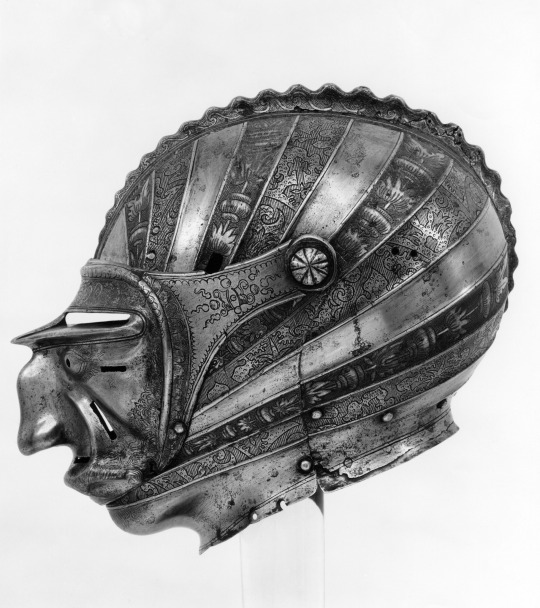
Kolman Helmschmid, Close Helmet with Mask Visor in Form of a Human Face, ca. 1515
#quayrund#art#Illustration#design#graphic design#photography#vibe#core#Aesthetic#cute#Mood#moodboard#esoteric#magic
67 notes
·
View notes
Text
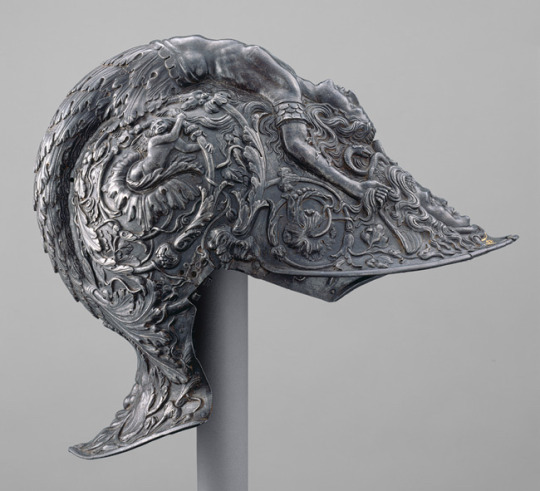
Kolman Helmschmid ca 1530
46 notes
·
View notes
Photo

Mitten Gauntlet for the Left Hand, Kolman Helmschmid, 1514, Art Institute of Chicago: Arms, Armor, Medieval, and Renaissance
George F. Harding Collection
Size: L. 26.7 cm (10 1/2 in.)
Medium: Steel, leather, and brass
https://www.artic.edu/artworks/116431/
18 notes
·
View notes
Text





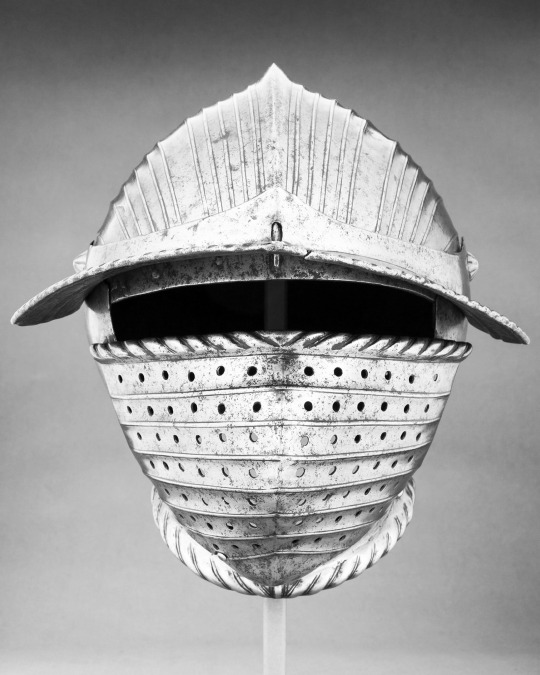



Part 1.
Three-Quarter Armor.
Pauldrons and vambraces attributed to Kolman Helmschmid (German, Augsburg 1471–1532).
Date: ca. 1525 and later.
Culture: German, Augsburg.
Medium: Steel, leather.
Dimensions:
Wt. 48 lb. 7 oz. (21.97 kg); helmet (a); H. 12 in. (30.5 cm); W. 11 in. (27.9 cm); D. 12 1/2 in. (31.8 cm); Wt. 6 lb. 1.2 oz. (2755.6 g); gauntlet (p); H. 10 1/2 in. (26.7 cm); W. 5 in. (12.7 cm); D. 4 3/8 in. (11.1 cm); Wt. 1 lb. 4.5 oz. (581.2 g); gauntlet (q); H. 10 1/2 in. (26.7 cm); W. 5 in. (12.7 cm); D. 4 3/8 in. (11.1 cm); Wt. 1 lb. 5.5 oz. (609.5 g); mail sleeve (r): L. 25 1/2 in. (65.0 cm); H. at shoulder 10 3/16 in. (26.0 cm); Diam. (outside) of chest links 5/16 in. (7.6 mm); Diam. (inside) of chest links 3/16 in. (4.8 mm); Diam. (outside) of sleeve links 5/16 in. (7.7 mm); Diam. (inside) of sleeve links 7/32 in. (5.8 mm); mail sleeve (s): L. 26 13/16 in. (68.0 cm); H. at shoulder 11 in. (28.0 cm); Diam. (outside) of chest links 11/32 in. (8.6 mm); Diam. (inside) of chest links 3/16 in. (4.8 mm); Diam. (outside) of sleeve links 9/32 in. (7.1 mm); Diam. (inside) of sleeve links 7/32 in. (5.6 mm).
The Metropolitan Museum of Art.
The pauldrons (shoulder defenses), and vambraces (arm defenses) of this armor are attributed to Kolman Helmschmid based on comparison with his known works. The associated helmet’s (acc. no. 50.237.2) distinctive snub-nosed visor appears to be a form that he originated and used on three other helmets, all dating from the mid-1520s. The decoration of these elements is typical of the style of Daniel Hopfer of Augsburg (about 1470–1536), a celebrated armor-etcher and printmaker, who is known to have decorated armors made by members of the the Helmschmid family.
The remainder of this armor is composed of southern German elements from about 1520 to 1530, except for minor restorations.
46 notes
·
View notes
Photo
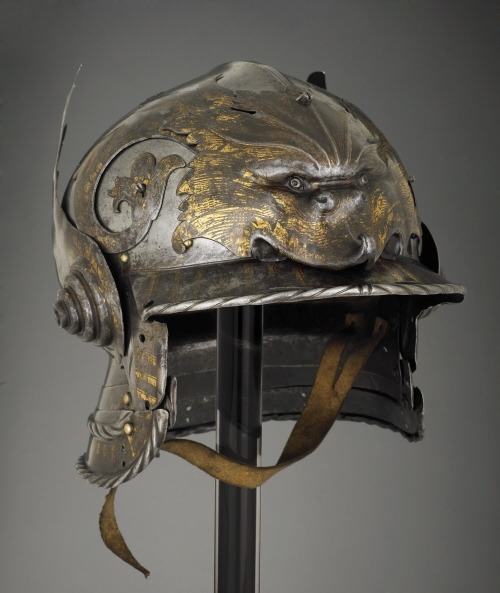
Burgonet crafted by Kolman Helmschmid of Augsburg, Germany, circa 1520.
from The Wallace Collections
151 notes
·
View notes
Text

A pair of heavily articulated Gauntlets, attributed to Kolman Helmschmid,
Length: 8.1 in/20.5 cm
Width: 4.9 in/12.5 cm
Depth: 4.9 in/12.5 cm
Weight: 14.1 oz/400 g
Augsburg, Germany, ca. 1530, housed at the Kunsthistorischesmuseum, Vienna.
#armor#gauntlets#europe#european#germany#german#augsburg#hre#holy roman empire#renaissance#khm#art#history
385 notes
·
View notes
Photo

Costume Armor made by Kolman Helmschmid (German, Augsburg 1471–1532)
Steel, gold
The Metropolitan Museum of Art
22 notes
·
View notes
Text

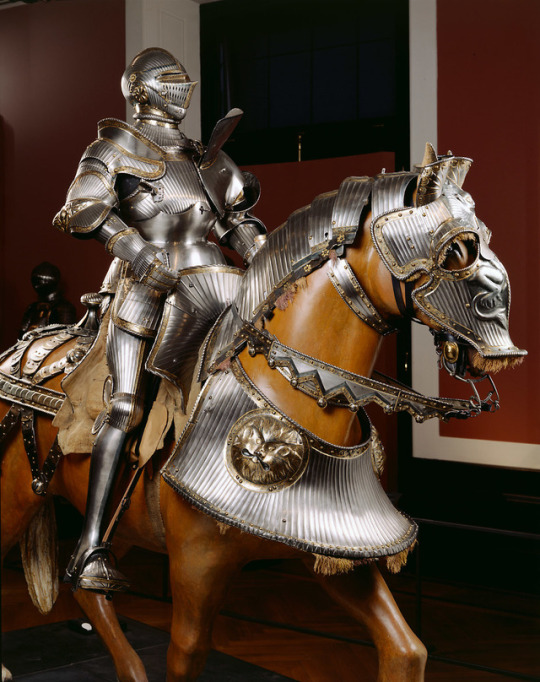
▪︎Rider Harness (Küriss) for field and tournament.
Place of origin: Augsburg
Date: 1526
Owner: Emperor Ferdinand I. Son of Philip of Habsburg Austria (1503 - 1564)
Maker: Kolman Helmschmid, (Plattner) (1471 - 1532, active in Augsburg)
Medium: Naked iron, goldsmelt, grooved, brass, leather.
#16th century#16th century art#16th century armor#armor#rider harness#field#tournament#augsburg#ferdinand i#emperor#1526#history#museum
149 notes
·
View notes
Photo
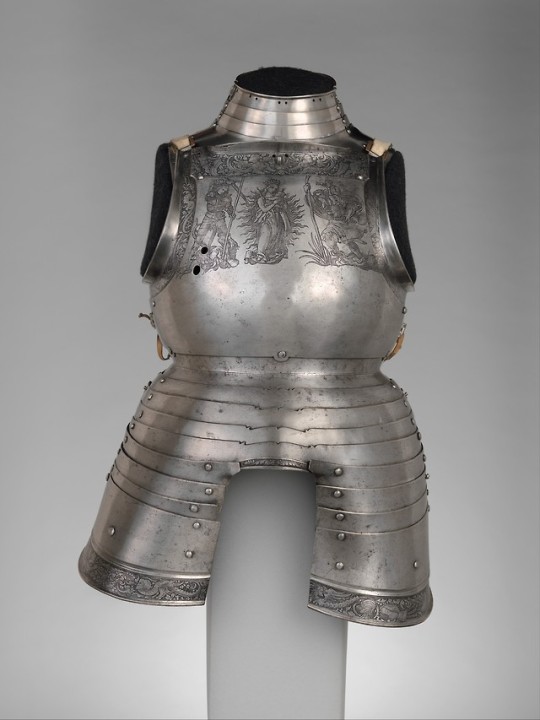


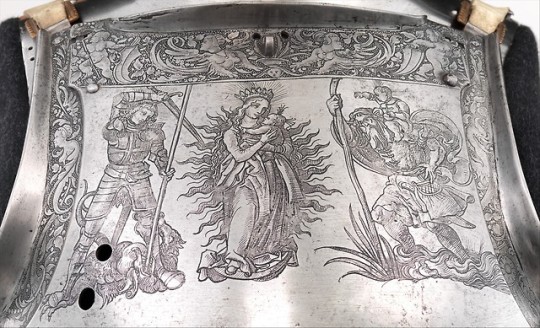


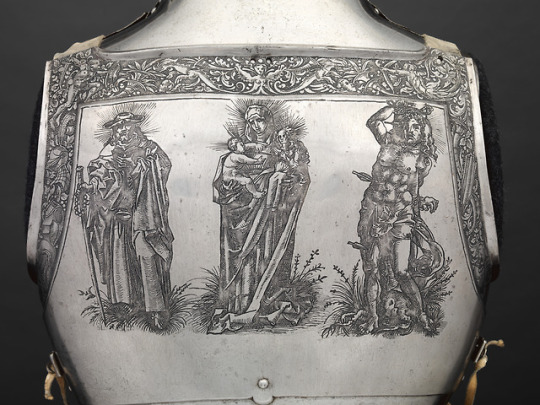
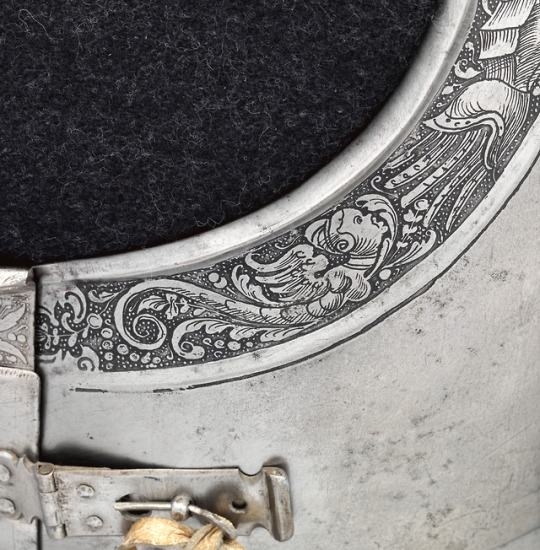


Cuirass and Tassets (Torso and Hip Defense), ca. 1510–20
Armorer: Attributed to Kolman Helmschmid (German, Augsburg 1471–1532)
Decorator: Etching attributed to Daniel Hopfer (German, Kaufbeuren 1471–1536 Augsburg)
Geography: Augsburg
Culture: German, Augsburg
Medium: Steel, leather
Dimensions: H. 41 1/2 in. (105.4 cm); Wt. 19 lb. 8 oz. (8845 g)
Credit Line: Gift of Marshall Field, 1938
The decoration of this armor is an outstanding example of German figural etching, inspired by contemporary print sources, as it was used to embellish armor. The etching has been attributed to Daniel Hopfer, a noted printmaker and armor etcher. Hopfer may have pioneered the technique of making prints from an etched metal plate, which revolutionized printmaking in the sixteenth century.
The figures on the breastplate depict major Christian saints and include the Virgin and Child flanked by Saint George and Saint Christopher. On the backplate, Saint Anne with the Virgin and Child is flanked by Saint James the Great and Saint Sebastian. The figure of Saint Sebastian pierced by arrows is copied from a woodcut made about 1507 by Hans Baldung Grien (1484 or 1485–1544).
The Metropolitan Museum of Art, New York
#TheMET
138 notes
·
View notes